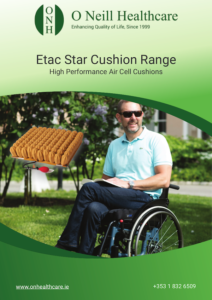Whether you are buying a wheelchair privately or being prescribed a chair by a Healthcare Professional, it is useful to know what is available and how it will perform. Performance with independence is an achievable goal.
When prescribed by a healthcare professional, a wheelchair will have been chosen based on their expert understanding of the user’s requirements.
However, when you are choosing the wheelchair yourself, it is important that you also understand these requirements and the option you choose should depend on a number of factors, including lifestyle, condition, posture requirements, independence, cost and more.
To help you understand more about the options, we’ll take a look at what the different styles of wheelchairs do and explain the differences between a rigid frame and a folding frame wheelchair. We can also explain why someone would buy a folding chair as opposed to a rigid chair.
So, what is the difference?
Rigid Frame Wheelchair
A rigid frame wheelchair is one with a welded frame that the user sits. It is often a custom built device made from a lightweight material (aluminium, steel, carbon fibre or titanium).
Rigid frame wheelchair users are usually upwardly mobile individuals who transfer easily from chair to vehicle. Many drive adapted vehicles so their wheelchairs need to be light enough to transfer across their laps once the wheels have been removed and stowed behind the driver’s seat.
Commonly these chairs are not crash tested so they are not suitable or safe to sit in while in a car, bus or taxi.
Rigid frame wheelchairs usually have a “fixed” front end that can be tapered in to suit the lower legs. The footplate is normally a double bar system or a small plate to support the users 2 feet neatly side by side.
One of the main attributes of a rigid frame wheelchair is they efficiently transfer all of the users energy into propelling the chair forward or backward. Folding frame chairs don’t always achieve this attribute as the frame can distort on propulsion, thus losing a large percentage of the initial “push”.
Folding Frame Wheelchairs
Folding manual wheelchairs usually have a folding cross brace (X-shaped) under the seat to allow the chair to fold up when not being used or when going into the boot of a car.
The leg rests and armrests are usually removable and height adjustable to suit the user’s needs. Normally the footplates “flip up” to facilitate standing or transferring by hoist.
A headrest can be fitted to most folding chairs and most folding chairs available on the Irish market will be Crash Tested and suitable for use in a wheelchair taxi or bus that has been adapted for such use. Always ask this of a seller before purchasing a wheelchair.
Usability and performance
When deciding what wheelchair will work best for you it is important to consider several pertinent questions:
- Should I contact an Occupational Therapist to assess me for my wheelchair?
- How long am I going to sit in my chair each day?
- Will I be propelling the chair myself or should I buy an attendant operated chair?
- Do I require a pressure relieving cushion?
- Who is going to measure me to ensure that I have the correctly sized chair?
- Will the chair be suited to my height, weight, limb length for self-propelling etc?
- Is my posture slumped or do I look tall and upright?
An Occupational Therapist or a well-trained wheelchair salesperson will take all of these factors into consideration when prescribing a wheelchair that will not only suit you and meet your expectations, but also suit your environment and the needs of those you interact with.
A wheelchair that is properly set up gives the occupant the best possible chance of for getting from A to B in an efficient manner and increases their independence.
Transportation and storage
One of the benefits of a foldable wheelchair is of course that they can be folded up. When folded they take up much less space, which makes them easier to store and transport. Most can easily fit into a small closet or in the trunk of a vehicle.
Your wheelchair should be easy to fold and unfold and the taking off of armrests and legrests should be a one-handed exercise to help in the folding process.
Quick release wheels are a must if you buy a self-propelling folding wheelchair, to help get it into the smaller car boots.
Rigid frame wheelchairs on the other hand usually require their own seat in a vehicle such as a van to transport it from one location to another. They can also be cumbersome to store because they don’t fold inwards.
Terrain
A foldable wheelchair moves over rough surfaces more easily than a rigid frame wheelchair.
Because foldable chairs offer more flexibility, all 4 wheels can maintain better contact with the terrain even if the ground is uneven or rough.
Due to their tendency to flex, folding frames offer a softer “suspension”, enhancing the ride for the occupant. Pneumatic wheels also can offer a more comfortable ride, but do beware of the dreaded puncture.
Transfer of effort and power
If the wheelchair user is going to be propelling the chair themselves, the transfer of effort to power and motion has to be considered.
With a rigid frame, the energy transfer tends to be very efficient. As there is no give in a rigid frame, any effort invested in propelling the wheelchair forward is directly transferred into powering the user and chair forward.
Because of the flexibility of folding frames, some of the energy from every push is lost within its frame as it flexes, which can lead to quicker fatigue for the user.
Foot/Arm placement
When choosing a wheelchair it is very important that the user is assessed for a chair that allows for adequate leg length from the back of the knee to the back of the buttocks.
The armrests should be set at a height that allows for easy resting of the forearms on the pads without pushing the shoulders skywards. The legrests should be length adjustable so as to allow the thighs to be fully supported by the seat canvas or cushion.
Legrests set too short can lead to pressure issues and general poor posture.
Best of both: The Cross 5 wheelchair
The Etac Cross 5 folding wheelchair is an all round wheelchair perfect for those looking for all the benefits of a folding frame wheelchair with the performance of a rigid frame wheelchair. The Cross has been around for decades, currently on version 5.
Thanks to its design, there is no distortion of the frame of the wheelchair during propulsion. This means that the Cross 5 wheelchair converts the user’s effort into forward power without the loss of power that is a problem for most traditional folding wheelchairs.
It is also highly adjustable, another of its stand-out features. The Cross 5 has 38 different wheel positions which allow the chair to be easily optimised for maximum user efficiency.
Because of the strength of the chair, the Cross 5 is also very hard wearing and these features combined mean it can be reused for years or recycled.
Click here for more information on the Etac Cross 5 folding wheelchair or download the brochure at the link below:
Ask a professional
Hopefully this article has clarified some of the key differences between a rigid frame wheelchair and a folding frame wheel but you should always make sure to speak with a healthcare professional before making a final decision.
Our experienced product specialists (sales@onhealthcare.ie) can also help you to decide which option meets your requirements or those of a loved one.



